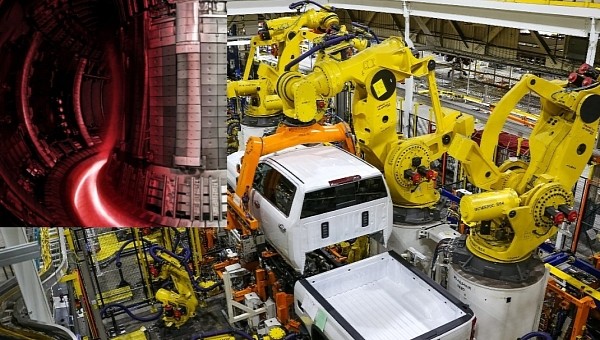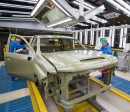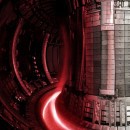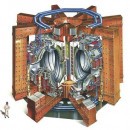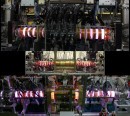Back in the 1950s, the Ford Motor Company was fairly certain that nuclear fission power was the way forward in the automotive industry's far future. Happily, Ford's engineers had better sense than scaling down a fission reactor and shoving it in the rear of a concept car.
Sixty-five years after the Ford Nucleon fiasco, humanity's just hit another breakthrough with a different, far more complicated form of nuclear energy; nuclear fusion. At the National Ignition Facility in California, scientists recently smashed the proverbial glass ceiling known as scientific breakeven. The point where the level of energy output by a fusion reaction exceeds the energy needed to generate the reaction in the first place.
What does this mean for the auto industry? Well, let's put it this way. If you think electric vehicles are only masking the problem of climate change by not making any emissions post-production, that's only the fault of the factories building them. Granted, the EPA themselves state EVs have a smaller carbon footprint than the equivalent ICE car. But is it really small enough to make a difference?
A great many automotive production facilities are still powered by fossil fuel-derived energy like coal and natural gas, whether they build electric vehicles or not. There's even one tire factory in Turkey whose parent company, Petlas Tyres, owns a neighboring coal-fired power station. This power station is purported to cover some of the plant's operating costs.
Though this is a somewhat rare and extreme case of the industry's dependency on dino juice, it does serve as an interesting focal point to the problem at hand. The world is still cripplingly dependent on fossil fuels, and nuclear fission is far too costly and politically polarizing to compensate on its own.
But where fission evokes images in the mind's eye of meltdowns, radiation sickness, and entire cities laid to waste in fallout, fusion is quite the opposite. A public image of basically limitless, cheap energy with relatively few downsides permeates sci-fi culture. As does the potential for the next generation of nuclear-powered rocket engines. In short, fusion rules and fission drools if you're not a nuclear engineer.
Of course, nuclear science is never that simple. Modern generation-III and III+ nuclear fission reactors are remarkably different and far safer than the RBMK Reactor, which had a big boogaloo in Ukraine in April 1986. Apart from the Fukushima Daiichi disaster caused by an earthquake outside of anyone's control, fission reactors in North America, Europe, Asia, and the world over have had remarkable safety records since the events at Chornobyl (Chernobyl).
This squeaky-clean accident record post-2011 has us thinking it's high time global politicians put the fear-mongering around nuclear energy to bed and devise a plan to implement the technology safely and for the benefit of every sector of society. That includes the automotive sector. No matter the type of vehicle built, be it gas, electric, or magic, the energy costs to build one vehicle are astronomical. We think the wombo-combo of fission and fusion nuclear energy has the potential to meet demand.
One study published by the Conference on Manufacturing Systems in 2012 detailed how the energy consumption just to power all the welding robots in a modern car factory consumes as much as about 288 MJ per car (80 kWh/car). Another study by the Swiss science publication MDPI determined it took as much as 55,000 MJ (megajoules) to produce a single car. For us petrolhead-minded, that's the equivalent of roughly 475 gallons (1,800 liters) of gasoline's worth of energy.
With the National Ignition Facility's scientific breakeven netting an energy gain of 1.5 MJ, it's tough to judge how soon this can be scaled to support vast swaths of energy infrastructure, the auto industry included. This, of course, leads to the problem of how to plan this nuclear future in specific detail.
At the present day, the American National Energy Institute estimates 92 separate nuclear reactors are active across 28 states. The states of Illinois and Pennsylvania alone account for over 21 percent of that number with 20 reactors between them. It's difficult to say for certain how many of the 150-plus automotive production facilities in America rely on nuclear energy for at least a portion of their energy consumption.
Whatever that figure turns out to be, it's nowhere near enough, in our opinion. That's why, if you ask us, the implementation of reliable nuclear fusion at some point in the near future will have effects so profound that the automotive sector would simply be another collateral effect of quick, decisive change. Could the end result be an electrical grid that can charge your Tesla, Rivian, or whatever you choose for next to nothing?
If the full exploits of fusion energy are fully realized, free EV charging would just be the tip of the iceberg. One can't help but think fusion power would do wonders for solving the microchip shortage once and for all. Of course, we're still at least a short wait away from all of this taking place. But now that scientific breakeven is at hand, you should start being a lot less pessimistic.
What does this mean for the auto industry? Well, let's put it this way. If you think electric vehicles are only masking the problem of climate change by not making any emissions post-production, that's only the fault of the factories building them. Granted, the EPA themselves state EVs have a smaller carbon footprint than the equivalent ICE car. But is it really small enough to make a difference?
A great many automotive production facilities are still powered by fossil fuel-derived energy like coal and natural gas, whether they build electric vehicles or not. There's even one tire factory in Turkey whose parent company, Petlas Tyres, owns a neighboring coal-fired power station. This power station is purported to cover some of the plant's operating costs.
Though this is a somewhat rare and extreme case of the industry's dependency on dino juice, it does serve as an interesting focal point to the problem at hand. The world is still cripplingly dependent on fossil fuels, and nuclear fission is far too costly and politically polarizing to compensate on its own.
But where fission evokes images in the mind's eye of meltdowns, radiation sickness, and entire cities laid to waste in fallout, fusion is quite the opposite. A public image of basically limitless, cheap energy with relatively few downsides permeates sci-fi culture. As does the potential for the next generation of nuclear-powered rocket engines. In short, fusion rules and fission drools if you're not a nuclear engineer.
Of course, nuclear science is never that simple. Modern generation-III and III+ nuclear fission reactors are remarkably different and far safer than the RBMK Reactor, which had a big boogaloo in Ukraine in April 1986. Apart from the Fukushima Daiichi disaster caused by an earthquake outside of anyone's control, fission reactors in North America, Europe, Asia, and the world over have had remarkable safety records since the events at Chornobyl (Chernobyl).
This squeaky-clean accident record post-2011 has us thinking it's high time global politicians put the fear-mongering around nuclear energy to bed and devise a plan to implement the technology safely and for the benefit of every sector of society. That includes the automotive sector. No matter the type of vehicle built, be it gas, electric, or magic, the energy costs to build one vehicle are astronomical. We think the wombo-combo of fission and fusion nuclear energy has the potential to meet demand.
One study published by the Conference on Manufacturing Systems in 2012 detailed how the energy consumption just to power all the welding robots in a modern car factory consumes as much as about 288 MJ per car (80 kWh/car). Another study by the Swiss science publication MDPI determined it took as much as 55,000 MJ (megajoules) to produce a single car. For us petrolhead-minded, that's the equivalent of roughly 475 gallons (1,800 liters) of gasoline's worth of energy.
With the National Ignition Facility's scientific breakeven netting an energy gain of 1.5 MJ, it's tough to judge how soon this can be scaled to support vast swaths of energy infrastructure, the auto industry included. This, of course, leads to the problem of how to plan this nuclear future in specific detail.
At the present day, the American National Energy Institute estimates 92 separate nuclear reactors are active across 28 states. The states of Illinois and Pennsylvania alone account for over 21 percent of that number with 20 reactors between them. It's difficult to say for certain how many of the 150-plus automotive production facilities in America rely on nuclear energy for at least a portion of their energy consumption.
Whatever that figure turns out to be, it's nowhere near enough, in our opinion. That's why, if you ask us, the implementation of reliable nuclear fusion at some point in the near future will have effects so profound that the automotive sector would simply be another collateral effect of quick, decisive change. Could the end result be an electrical grid that can charge your Tesla, Rivian, or whatever you choose for next to nothing?
If the full exploits of fusion energy are fully realized, free EV charging would just be the tip of the iceberg. One can't help but think fusion power would do wonders for solving the microchip shortage once and for all. Of course, we're still at least a short wait away from all of this taking place. But now that scientific breakeven is at hand, you should start being a lot less pessimistic.
